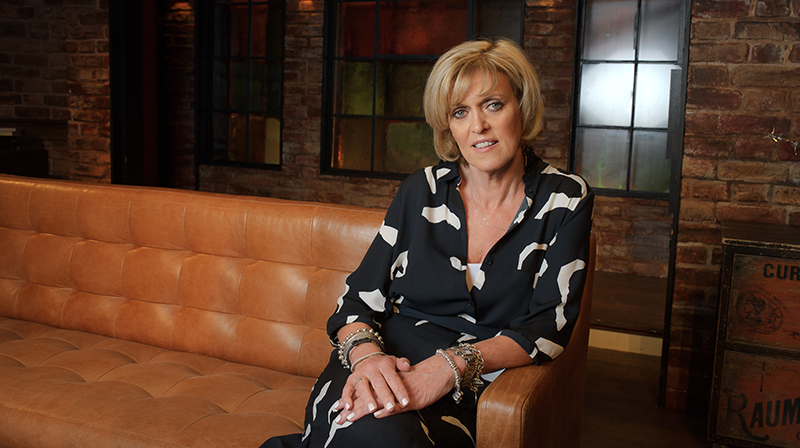RTÉ’s Group Head of Commercial Geraldine O’Leary talks to John McGee about the many challenges and opportunities the Donnybrook broadcaster faces as it embarks on its new five-year plan.
These are challenging times for the Irish media industry. For RTÉ, the largest media company in the country, the challenges are particularly acute. Given that it has a clearly definable public service mandate and depends on more than 50% of its total income on the licence fee, the challenges are also unique. Given that over the last 10 years the broadcaster has seen its commercial income fall by as much as €90m or 36%, change is clearly needed.
While it is easy to dismiss all of this as the broadcaster’s own fault and changing consumption patterns, the underlying trends in the wider Irish media market don’t bode well for the media industry sector in general. But certain things like an increase in the licence fee or the introduction of a household media charge or, at the very least, reducing licence fee evasion, need to be discussed. Other issues like retransmission fees will also be up for debate.
To its credit, RTÉ churns out serious amounts of important and quality content day-in-day-out in areas like current affairs, culture, Irish language, sports and entertainment. The only ask is that people pay €160 a year – or 45 cents a day- for their TV licence and that advertisers, of course, look favourably at the depth and breadth of it is offering. But as RTÉ’s director general, Dee Forbes, recently told the Public Accounts Committee, “the greatest risk to public service broadcasting in Ireland and many other countries is restricted funding at a time of unprecedented competitive threats and fast-changing media consumption habits.”
For Geraldine O’Leary, the recently-appointed Group Head of Commercial at RTÉ, the many challenges the broadcaster faces are being openly embraced. As a former Commercial Director of RTÉ Television since 2003 – and before that manager of TV sales since 1997- they are also challenges that she believes, can be addressed with the right thinking, strategy and structure.
“Very few companies would be able to sustain the losses that we’ve sustained in recent years, so we are lucky that we are here to tell the tale,” she says.
“We’ve got to change the model and we are in the process of doing that. We believe that it will future-proof RTÉ. It doesn’t matter what business you have, if you’re spending more money than you earn then you’re in trouble. And we’ve been spending more money than we earned in recent years. At a time when commercial revenues have been under considerable pressure, it wasn’t sustainable. Since our Director General Dee Forbes came in here nearly two years ago, we’ve been working on developing the new model and new structure. We now know the changes that need to be made and we’ve started the process. We have to be patient though and it is going to take some time.”
“We’ve got to change the model and we are in the process of doing that. We believe that it will future-proof RTÉ. It doesn’t matter what business you have, if you’re spending more money than you earn then you’re in trouble.”
The new five-year plan, which was unveiled in February and called Renewing RTÉ for the Next Generation 2018-2022, sets out proposals to focus more on digital platforms and presents its plans to remain relevant for younger audiences as traditional broadcasters square up to digital streaming services like Netflix and Amazon. With plans to invest more in digital content – particularly short-form- as well as a new revamped RTÉ Player and a Digital Lab, its commercial strategy has been revamped. Parallel to all of this, of course, has been the departure of staff through voluntary redundancy.
Previously the company had separate commercial divisions focused around digital, TV and radio. Under its One RTÉ proposition, all of these have now become integrated and seamless.
“I think of it as the integration of our entire individual platform offerings into one cohesive distinctive brand. The key principle is that our audience comes first and this works both at an organisational level and equally for us as a commercial department,” says O’Leary.
“From an internal perspective, this will result in a more agile, collaborative workforce, and will lead to greater efficiency. Our commercial strategy is completely aligned with this and we are representing ‘One RTÉ’ in all discussions with clients and agencies. Our B2B marketing to the marketplace is supporting this with a simple clear message – together is better.
“The flipside to all the different challenges we face, however, is that change can be really exciting and good for an organisation like RTÉ. Having one commercial division makes sense and it’s something that I’ve believed in for quite some time. So, for me, this change is giving us the opportunity to do something that can really make a difference. We must look at everything that we do and how we can do it more effectively,” says O’Leary.
After two years of modest growth between 2014-2016, the TV advertising market in Ireland declined in 2017 to end up at around €219m, according to research by Core. This year, it could fall again to around €216m, making the environment in which the largest broadcaster operates very tricky.
“I think that the commercial environment at the moment is very difficult. I know peers within the industry will probably say the same. The last year was very tough. “We’ve got two economies here: the indigenous economy and the economy which includes the Apples, Googles and Facebooks of this world and they are operating in a much healthier world than the indigenous one,” says O’ Leary.
If you take the digital market for example, of every additional euro spent in the market, at least 80% went to Facebook and Google in 2017. It’s the same for 2018. I find it quite extraordinary that whatever happens Facebook or Google in terms of the different controversies that have happened recently, the money keeps rolling in and unfortunately for the rest of the media industry, I can’t really see that changing for the foreseeable future. So, the reality is that we are competing in a smaller pool and it’s going to be another difficult year,” she says.
With issues like ad fraud and brand safety dominating many industry debates and some advertisers questioning the return on investment in digital, surely this is a good time for the likes of TV, radio and indeed print to be demonstrating their effectiveness as platforms? Numerous studies of advertising effectiveness down through the years have shown that TV, for example, is a powerful brand-building platform.
“What we can do is to continue to talk about the fact that our platforms are trusted, that they offer a brand safe environment to our advertising clients and that we have the reach that they are seeking. I think clients really like this; they know that each RTÉ platform – radio, TV, print and digital offer quality environments and they, thankfully, recognise there is a premium for that. But then, many advertisers go and spend their money elsewhere in environments that are not as safe. So, again it all boils down to the difference between what people say and what people do,” she adds.
As the advertising market becomes more commoditized there is a distinct danger that this will result in a race to the bottom and that’s not good for RTÉ or indeed the wider Irish media industry.
“It genuinely isn’t good for the industry. I’ve had conversations with some of the media agency MDs about this, particularly around the whole price versus value argument. The bottom line is that you need to interrogate the value of what you’re being offered, and not just the price. Whilst agencies agree with this in theory, they are often judged and more importantly paid on the result- which can be a discount number.
“This is something that really annoys me as it’s sending the entire industry spiralling in one direction where cheap is valued as good. Cheap is not necessarily the same as good value and it’s important that clients and agencies understand this,” she says.
Historically, advertising investment growth has tended to track economic growth in Ireland. With the Irish economy now firing on all cylinders, however, this no longer seems to be the case, a further challenge the wider market has to contend with. And, of course, the looming prospect of Brexit and a possible recession in the UK, is not helping matters either.
“It’s becoming increasingly difficult because when the decision maker is based in Greater London and has responsibility for the UK, Ireland and even the Nordic countries, they often don’t view Ireland in the same way as we do”.
Whilst most international companies continue to advertise with RTÉ, the reality is their advertising spend is often controlled from the UK. For Irish media companies, including RTÉ, getting access to these budgets and the key decision makers is a constant challenge. The Irish market is often viewed as too small to make a real difference to the overall results.
“It’s becoming increasingly difficult because when the decision maker is based in Greater London and has responsibility for the UK, Ireland and even the Nordic countries, they often don’t view Ireland in the same way as we do,” says O’Leary.
While the linear TV market will remain challenged for the foreseeable future, the RTÉ Player has been singled out for extra special attention. In the same way that its competitors like SKY, C4 and the BBC iPlayer have all developed strong online offerings to compete with the likes of Netflix and Amazon, RTÉ has also been busy building up its online offering to include content that is made exclusively for the platform. And we can expect to see a lot more of this in the future, says O’Leary.
“Part of what we are trying to do is to respect the fact that people are watching our content in different ways and because of this we’re investing a lot in our Next Generation Player which is planned to be released before the end of the year. We want to keep people in the RTE ecosystem. The longer we can keep them moving around within our ecosystem, the better it will be for us from a commercial perspective. But as ever, it is always about providing the content they want first and that’s what we will be aiming to achieve.
“We already have a fantastic and unrivalled archive and we are now commissioning lots of exciting small, short-form content for the new Player which will resonate with a wide audience because across all our different platforms, we have to try and reach everybody with relevant content because that’s what providing a public service is all about,” she adds.
Content, of course, can be expensive to create. RTÉ’s investment in independent productions, for example, has halved from €79.5m in 2007 to just €40m in 2016. In addition, it has had to forego some major live sports rights simply because the costs were too prohibitive.
“We can’t spend money we don’t have. In fairness to Adrian Lynch (Director of Audience, Channels and Marketing), and Jim Jennings (Director of Content), they have a significant budget and do a really good job of working within it, but they also have to make choices that are sometimes difficult. Losing the Six Nations was a real sucker-punch for everyone here but there has to be a point beyond which we can’t go. And this is part of the public service DNA – we’re spending not just commercial revenue but also licence payer revenue as well and we have to have that in our heads when we go into any negotiation. And however hard it is, and that was a particularly tough one, there’s a point where you say we can’t go any further, and we did,” she says.
With live sports top of the agenda for many broadcasters, the market for broadcasting rights looks set to become even more competitive over the coming years she says.
“Apart from the traditional broadcasters, there are the likes of Twitter, Amazon and Facebook getting in on the action so it’s inevitable that sports rights are going to be a lot more hotly contested in the future. While we don’t have the very deep pockets they have, but we will continue to fight and compete to get our share because sport is one of the great definers of Ireland as a nation and it’s important that we reflect this.”
The other key focus for RTÉ is its radio output and the challenges and opportunities it faces. While the recent batch of figures from the JNLR show that radio continues to hold its own in terms of listenership figures, some of the forecasts for the sector that were published by media agencies earlier in the year were downbeat.
“The Irish listeners’ relationship with radio has always been significantly deeper and higher in terms of the numbers listening when compared to most countries, particularly the UK. Most households have a radio in nearly every room, so I am surprised with some of the negativity surrounding radio. What I do know is that the radio industry here in Ireland – and not just RTÉ- is determined to get things right and at a top level there’s a number of things that need to be done including qualitative research that shows how advertising on radio actually works. We have lots of research for TV but not enough for radio. But it will happen. The Irish radio industry is very good when it comes to collaborating and it has made great strides when it comes to getting out there in the marketplace as a combined industry,” says O’Leary.
In the case of RTÉ, she says the broadcaster’s radio revenues were up last year. “We had a very good year in radio last year both in terms of revenue and audience. Revenue was up last year, with RTÉ Radio One in particular having a good year and we’re not just talking about a tiny percentage growth. We had good spot revenue last year at a time when the industry was talking down radio. In fact, what people were saying about radio and what we were experiencing were two different things. It started well again this year and I believe that 2fm is a jewel in our crown. Dan Healy (Head of Radio Strategy), is doing a great job in turning it around. It’s becoming, dare I say, cool again and there’s lots of initiatives that are being implemented that are breaking through and resonating with the audiences we want to reach. It’s now up to us to convince advertisers and agencies to take this on board,” she says.
While RTÉ-bashing has become a popular blood sport in other media outlets, what constitutes public service broadcasting in the 21st century also become a topic of debate in recent years and do people care?
“Absolutely, I think people do care. When Big Tom passed away, the Late Late Show did a country music special to commemorate him. What other broadcaster would have done that? Our job is to make sure that somewhere in our schedule there is something for everybody. No other broadcaster needs to do that. If you look at the variety we have in our schedule in its entirety, including radio and TV, no other broadcaster would match our output in terms of current affairs, drama, culture, the arts and children’s programming. We do all of this because that’s what a public service broadcaster has to do and should do. The BBC, for example, have done things in the past where they’ve asked people to imagine a world without the BBC and the reality is it’s very hard to do that. I certainly can’t imagine a world without RTÉ,” she concludes.
And she wouldn’t be the only one.
First published in Irish Marketing Journal (IMJ April 2018)© to order back issues please call 016611660






















